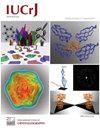利用第四代同步辐射进行酶和光感受器表征。
IF 3.6
2区 材料科学
Q2 CHEMISTRY, MULTIDISCIPLINARY
引用次数: 0
摘要
位于法国格勒诺布尔的欧洲同步辐射设施(ESRF)升级为极灿烂光源(EBS)后,有望实现亚毫秒级时间分辨率的时间分辨同步辐射序列晶体学(SSX)实验。ID29 是 ESRF-EBS 专用于 SSX 实验的新光束线。在此,我们报告 ID29 用户运行初期的实验结果。我们首先使用光活性黄色蛋白的微晶作为模型系统,以挖掘微秒脉冲在 SSX 方面的潜力。随后,我们用微秒 X 射线脉冲研究了细胞色素 c 亚硝酸还原酶(ccNiR)的微晶。CcNiR 是一种十血红素蛋白,非常适合研究各种血红素铁位点的辐射损伤。最后,我们通过光激活一种霉菌植物色素的微晶,进行了一次概念验证性的亚秒级时间分辨 SSX 实验。本文章由计算机程序翻译,如有差异,请以英文原文为准。
Exploiting fourth-generation synchrotron radiation for enzyme and photoreceptor characterization
(Time-resolved) macromolecular crystallography at the new ID29 beamline at the ESRF is described.
The upgrade of the European Synchrotron Radiation Facility (ESRF) in Grenoble, France to an Extremely Brilliant Source (EBS) is expected to enable time-resolved synchrotron serial crystallography (SSX) experiments with sub-millisecond time resolution. ID29 is a new beamline dedicated to SSX experiments at ESRF–EBS. Here, we report experiments emerging from the initial phase of user operation at ID29. We first used microcrystals of photoactive yellow protein as a model system to exploit the potential of microsecond pulses for SSX. Subsequently, we investigated microcrystals of cytochrome c nitrite reductase (ccNiR) with microsecond X-ray pulses. CcNiR is a decaheme protein that is ideal for the investigation of radiation damage at the various heme-iron sites. Finally, we performed a proof-of-concept subsecond time-resolved SSX experiment by photoactivating microcrystals of a myxobacterial phytochrome.
求助全文
通过发布文献求助,成功后即可免费获取论文全文。
去求助
来源期刊

IUCrJ
CHEMISTRY, MULTIDISCIPLINARYCRYSTALLOGRAPH-CRYSTALLOGRAPHY
CiteScore
7.50
自引率
5.10%
发文量
95
审稿时长
10 weeks
期刊介绍:
IUCrJ is a new fully open-access peer-reviewed journal from the International Union of Crystallography (IUCr).
The journal will publish high-profile articles on all aspects of the sciences and technologies supported by the IUCr via its commissions, including emerging fields where structural results underpin the science reported in the article. Our aim is to make IUCrJ the natural home for high-quality structural science results. Chemists, biologists, physicists and material scientists will be actively encouraged to report their structural studies in IUCrJ.
 求助内容:
求助内容: 应助结果提醒方式:
应助结果提醒方式:


